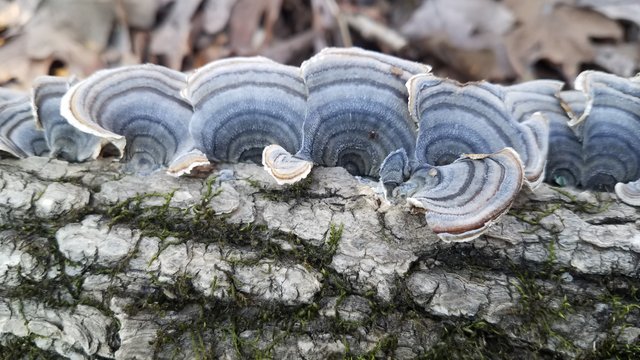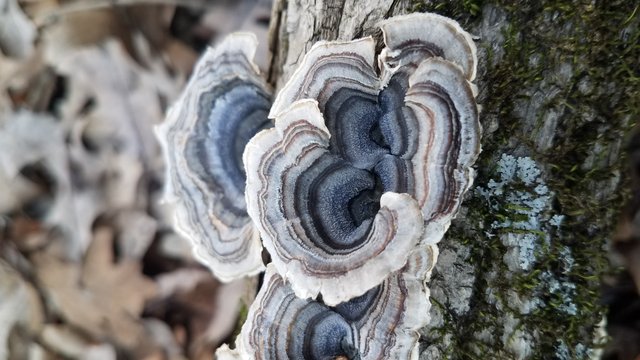For the past year or two, I have been completely fascinated with fungi. Of course, I had seen mushrooms growing in the yard and in the forest, but I had never really noticed them. I didn't really appreciate the role that they play in nature. There are mushrooms that fill all kinds of niches in nature. Some, like chanterelles, form a mutualistic relationship with the roots of trees, trading nourishment for water, carbon dioxide, and other substances. Others, like the cordyceps fungi parasitize insects. But the topic of my #AmazingNature entry is a saprobic fungus, meaning that it breaks down the cellulose in dead wood to obtain its nutrients. This is a tough task! There are relatively few members of the animal kingdom that can do it.
Beautiful Blue Trametes versicolor

Most wood gets decomposed by fungi. Now, for the uninitiated, the word 'fungus' illicits imagery of gilled mushrooms; however, a mushroom is just the fruiting body of a fungus. The actual body of the fungus, the tiny thread-like web of mycelia, lies beneath the surface that the mushroom is growing from. So, the appearance of these fan shaped mushrooms popping up from the a dead branch indicates that it is in the process of being broken down. Think about it: if not for these fungi and others like them, how long would fallen limbs and branches lie on the forest floor? They would pile up, tying up precious nutrients that other plants and animals need to thrive. They would represent a dead end in the carbon cycle, breaking the circle of life.
Allowing Nature's Spirit To live On

I submit that these turkey tail fungi (Trametes versicolor) represent the theme "Nature's Spirit" because they break lignin, cellulose, and other difficult to digest molecules down into smaller units that can be plugged back into the circle. It's almost like they are the conduit allowing nature's spirit to be passed on into the next iteration of the cycle.

(Read on to learn more about Trametes versicolor)
Turkey tail is one of the most common mushrooms in the world. It can be found growing on tree stumps and rotting wood throughout North America, Europe, and Asia. It is a saprobic fungus meaning that it breaks down cellulose and lignin from dead wood, and it may even be found growing as a parasite on living trees.
Name & Appearance
Both the scientific name and common name for this mushroom are based on physical descriptions of the fruiting body. The genus name Trametes translates to thin, and the species name versicolor means many colors. Indeed, the fruiting bodies are thin, and they may be found in several different color varieties. The most common color by far is brown to reddish brown color, so it does kind of resemble a turkey's tail with its fan-like shape.The fan shaped caps range in size from 2-8 cm across, up to 4 cm deep, and are usually about a millimeter or two thick. The top side of the cap will be velvety or hairy and will usually exhibit alternating concentric zones of texture and color including white, gray, brown, reddish brown, and even blue or green. Turkey tail is a polypore fungus, so the bottom side of the cap contains pores instead of gills. The pore surface of T. vesicolor is much more densely pored than most other species within the Trametes genus with about 3-8 pores per millimeter versus the 1-3 pores per millimeter exhibited by other species.
Identification
While turkey tail is super common to find out in the woods, it does have a few look-alikes to watch for. In fact, what most people collect as turkey tail mushrooms probably consists of a complex of similar species When trying to identify true turkey tail, the first thing that will catch your eye is the growth habit. You will see shelf-like rows of thin fan shaped structures densely growing on dead wood. Upon closer inspection, you should see those alternating concentric rings of color. Next, You will want to feel of the top of the cap. The fuzzy/velvety texture of T. versicolor distinguishes it from most other species within the genus, which exhibit a smooth cap. Now, flip it over. Most species within Trametes will have easily visible pores, but the pores of T. versicolor are so small and densely packed that they may be difficult to see without some magnification. In fact, this may be vital to properly distinguishing T. versicolor to some of the more similar looking species within the genus. A spore print will reveal whitish colored spores that appear as smooth, cylindrical structures about 4.5-5.5 μm long.There are a couple of mushrooms belonging to separate genera that are commonly mistaken for T. versicolor. Stereum ostrea looks very similar to turkey tail from a top view. However, an inspection of the underside will reveal a smooth, white to reddish brown surface lacking any pores whatsoever.. While a spore print for S. ostrea may be difficult to obtain, it will show up a whitish color that looks similar (though, maybe a little larger) to that of T. versicolor under magnification. The best way to distinguish the two species is to look at the underside of the cap with a magnifying glass. If you see pores, you probably have T. versicolor; no pores, it's more likely S. ostrea.
Another look-alike is Trichaptum biforme, commonly known as the violet toothed polypore. This one looks like an old faded specimen of T. versicolor from the top, but a look underneath the cap reveals tooth-like structures. In a fresh specimen, these tooth-like structures may take on a purple color; however, that color may fade to a more of a whitish shade in older specimen. Again, the key to distinguishing this mushroom from T. versicolor is looking under the hood. The former will have tooth-like structures; the latter will have densely packed pores.
Medicinal Properties
Turkey tail is one of the most widely studied fungi as far as medicinal properties go; and, it is probably one of the most promising. In fact, there is already a cancer drug called Polysaccharide-K that is used in conjunction with chemotherapy to reduce the negatives impacts from the treatment. Clinical evidence also indicates that chemical extracts from the mycelia of T. versicolor may help in the treatment of hepatitis, hyperlipidemia, chronic bronchitis, and may even enhance learning and memory. So, if you're into wholistic medicine, this easy-to-find fungus looks to be very promising!
@sustainabilityyours
I absolutely love your post on Turkey tail! It's funny cause I just made a post on turkey tail decoction yesterday! Haha what are the odds. Turkey tail has become my latest fungi obsession and I've been foraging for it a few times lately. I really enjoy the connection I feel to nature whilst foraging. In my post I wrote about how while we can go buy these extracts in stores or online, I prefer the experience I get going out and communing with nature and the spirit of the fungi. Check it out at https://www.naturalmedicine.io/naturalmedicine/@colibrifremedies/turkey-tail-from-the-woods-to-my-mug
Downvoting a post can decrease pending rewards and make it less visible. Common reasons:
Submit
Thank you for taking the time to check it out! Now that I'm getting more comfortable with identifying T. versicolor, I've been wondering how to process it into a usable form, so I'll definitely check out your link!
Downvoting a post can decrease pending rewards and make it less visible. Common reasons:
Submit
quality post! thank you. a pleasure to read for all fungi-lovers.
Downvoting a post can decrease pending rewards and make it less visible. Common reasons:
Submit
Thank you for checking it out!
Downvoting a post can decrease pending rewards and make it less visible. Common reasons:
Submit
Hello,
Your post has been manually curated by a @stem.curate curator.
We are dedicated to supporting great content, like yours on the STEMGeeks tribe.
Please join us on discord.
Downvoting a post can decrease pending rewards and make it less visible. Common reasons:
Submit
Downvoting a post can decrease pending rewards and make it less visible. Common reasons:
Submit